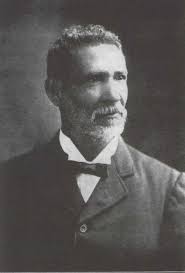Plessy v. Ferguson, 163 U.S. 537 (1896), was a landmark U.S. Supreme Court decision in which the Court ruled that racial segregation laws did not violate the U.S. Constitution as long as the facilities for each race were equal in quality, a doctrine that came to be known as "separate but equal". The decision legitimized the many state laws re-establishing racial segregation that had been passed in the American South after the end of the Reconstruction era (1865–1877).

Lake Pontchartrain is a brackish estuary located in southeastern Louisiana in the United States. It covers an area of 630 square miles (1,600 km2) with an average depth of 12 to 14 feet. Some shipping channels are kept deeper through dredging. It is roughly oval in shape, about 40 miles (64 km) from west to east and 24 miles (39 km) from south to north.

Separate but equal was a legal doctrine in United States constitutional law, according to which racial segregation did not necessarily violate the Fourteenth Amendment to the United States Constitution, which nominally guaranteed "equal protection" under the law to all people. Under the doctrine, as long as the facilities provided to each "race" were equal, state and local governments could require that services, facilities, public accommodations, housing, medical care, education, employment, and transportation be segregated by "race", which was already the case throughout the states of the former Confederacy. The phrase was derived from a Louisiana law of 1890, although the law actually used the phrase "equal but separate".

The Faubourg Marigny is a neighborhood of the city of New Orleans, Louisiana, United States.

John Lawrence Sullivan, known simply as John L. among his admirers, and dubbed the "Boston Strong Boy" by the press, was an American boxer recognized as the first heavyweight champion of gloved boxing, de facto reigning from February 7, 1882, to September 7, 1892. He is also generally recognized as the last heavyweight champion of bare-knuckle boxing under the London Prize Ring Rules, being a cultural icon of the late 19th century America, arguably the first boxing superstar and one of the world's highest-paid athletes of his era. Newspapers' coverage of his career, with the latest accounts of his championship fights often appearing in the headlines, and as cover stories, gave birth to sports journalism in the United States and set the pattern internationally for covering boxing events in media, and photodocumenting the prizefights.
Homer Adolph Plessy was an American shoemaker and activist, best known as the plaintiff in the United States Supreme Court decision Plessy v. Ferguson. He staged an act of civil disobedience to challenge one of Louisiana's racial segregation laws and bring a test case to force the U.S. Supreme Court to rule on the constitutionality of segregation laws. The Court decided against Plessy. The resulting "separate but equal" legal doctrine determined that state-mandated segregation did not violate the Fourteenth Amendment to the United States Constitution as long as the facilities provided for both black and white people were putatively "equal". The legal precedent set by Plessy v. Ferguson lasted into the mid-20th century, until a series of landmark Supreme Court decisions concerning segregation, beginning with Brown v. Board of Education in 1954.

The Illinois Central Railroad, sometimes called the Main Line of Mid-America, was a railroad in the central United States, with its primary routes connecting Chicago, Illinois, with New Orleans, Louisiana, and Mobile, Alabama. A line also connected Chicago with Sioux City, Iowa (1870). There was a significant branch to Omaha, Nebraska (1899), west of Fort Dodge, Iowa, and another branch reaching Sioux Falls, South Dakota (1877), starting from Cherokee, Iowa. The Sioux Falls branch has been abandoned in its entirety.

Bywater is a neighborhood of the city of New Orleans. A subdistrict of the Bywater District Area, its boundaries as defined by the City Planning Commission are: Florida Avenue to the north, the Industrial Canal to the east, the Mississippi River to the south, and the railroad tracks along Homer Plessy Way to the west. Bywater is part of the Ninth Ward of New Orleans; but it is located along the natural levee of the Mississippi River, sparing the area from significant flooding. It includes part or all of Bywater Historic District, which is listed on the National Register of Historic Places.

Albion Winegar Tourgée was an American soldier, lawyer, writer, politician, and diplomat. Wounded in the Civil War, he relocated to North Carolina afterward, where he became involved in Reconstruction activities. He served in the constitutional convention and later in the state legislature. A pioneer civil rights activist, he founded the National Citizens' Rights Association, and founded Bennett College as a normal school for freedmen in North Carolina.

Pontchartrain Rail-Road was the first railway in New Orleans, Louisiana. Chartered in 1830, the railroad began carrying people and goods between the Mississippi River front and Lake Pontchartrain on 23 April 1831. It closed more than 100 years later.

Baton Rouge station is a historic train station located at 100 South River Road in downtown Baton Rouge, Louisiana. It was built for the Yazoo and Mississippi Valley Railroad which got absorbed by the Illinois Central Railroad. The station was a stop on the Y&MV main line between Memphis, Tennessee and New Orleans, Louisiana. The building now houses the Louisiana Art and Science Museum.
John Howard Ferguson was an American lawyer and judge from Louisiana, most famous as the defendant in the Plessy v. Ferguson case.
The Separate Car Act was a law passed by the Louisiana State Legislature in 1890 which required "equal, but separate" train car accommodations for Blacks and Whites. An unsuccessful challenge to this law culminated in an 1896 United States Supreme Court decision, which upheld the constitutionality of state laws requiring racial segregation.

The Alabama Great Southern Railroad is a railroad in the U.S. states of Alabama, Georgia, Louisiana, Mississippi, and Tennessee. It is an operating subsidiary of the Norfolk Southern Corporation (NS), running southwest from Chattanooga to New Orleans through Birmingham and Meridian. The AGS also owns about a 30% interest in the Kansas City Southern-controlled Meridian-Shreveport Meridian Speedway.

Rodolphe Lucien Desdunes was an African-American civil rights activist, poet, historian, journalist, and customs officer primarily active in New Orleans, Louisiana.
The Comité des Citoyens was a civil rights group made up of African Americans, whites, and Creoles. It is most well known for its involvement in Plessy v. Ferguson. The Citizens Committee was opposed to racial segregation and was responsible for multiple demonstrations in which African Americans rode on the "white" cars of trains.

Little Woods was historically an unincorporated community on the shoreline of Lake Pontchartrain. The name in French, "La Petite Bois" or The Little Woods can be found on the 1883 Lafon-Alphonse Michoud Map drafted by civil-engineer George N. Grandjean. "Little Woods", as a place designation that continues in local use. Little Woods also directly relates to the treed hammocks that were high Chénier ridges bordered by water and wetlands.
Transport and bus boycotts in the United States were protests against the racial segregation of transport services prior to the passage of the 1964 Civil Rights Act, which outlawed such forms of discrimination.
Louisville, New Orleans & Texas Railway Co. v. Mississippi, 133 U.S. 587 (1890), was a case in which the Supreme Court of the United States upheld a Mississippi law that required railroads to racially segregate their passengers. The Court in Hall v. Decuir (1878) had struck down a similar Louisiana law on the grounds that it unreasonably interfered with Congress's power to regulate interstate commerce. A railroad challenged the Mississippi law on the same ground, arguing that it violated the Dormant Commerce Clause by burdening interstate commerce. The Supreme Court, dividing 7 to 2, disagreed. Writing for the majority, Justice David Josiah Brewer distinguished Hall on the basis that Mississippi's law, unlike Louisiana's, applied solely to intrastate commerce. Justices John Marshall Harlan and Joseph P. Bradley dissented. According to Harlan, the Mississippi law subjected all trains, including those involved in interstate commerce, to the segregation requirement. Finding no differences between the case and Hall, he voted to strike down the law.
CSS Pamlico was a sidewheel steamer that served in the Confederate States Navy during the early stages of the American Civil War. Originally a passenger vessel on Lake Pontchartrain, she was purchased by Confederate authorities on July 10, 1861, and converted into a gunboat. She participated in two minor naval actions in the vicinities of Horn Island and Ship Island in December, before taking part in two more small battles defending the Pass Christian area in March and April 1862. In late April, Union Navy ships passed the defenses of New Orleans, Louisiana. After ferrying Confederate troops out of the city, Pamlico was burned by her crew on Lake Pontchartrain on April 25 to prevent capture.












